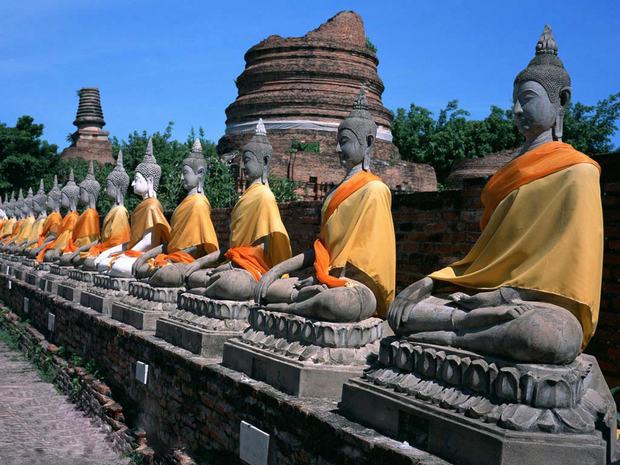Buddhism in China: Exploring its History, Influence, and Present-day Significance
Buddhism's arrival in China had a profound effect on a number of facets of Chinese culture, including literature, art, rituals, and more.
The Arrival and Spread of Buddhism in China
Buddhism was introduced to China gradually and over a long period of time. Around the beginning of the first century AD, Buddhist monks from India arrived. These monks took their special scriptures, doctrines, and teachings with them as well as translations of those texts into Chinese. It took some time before Buddhism gained acceptability and started to expand across the nation since these teachings were first only accessible to a small number of followers.Buddhist monks in China at this period experienced severe difficulties. The fact that Buddhism did not adhere to the conventional Chinese beliefs and values of the period posed one of the largest obstacles. The monks were forced to modify their practices and teachings in order to better meet the requirements and tastes of the Chinese people.
In spite of these obstacles, Buddhism expanded in China. As Buddhism's teachings gained acceptance, they started to impact Chinese society as a whole, moving beyond the small groups of monks. It started to have an effect on Chinese literature, philosophy, and art, and it even attracted certain members of the governing elite as adherents.
Buddhism still plays a significant role in Chinese culture today and has a huge impact on the lives of millions of people in China and around the world.

Buddhism in Different Dynasties of China
In China, Buddhism has a long and complicated history that spans multiple dynasties, each of which had a distinctive influence on the religion.Buddhism was brought to China during the Han Dynasty via the Silk Road and rapidly became widely accepted. But Buddhism didn't really take off and become one of the most popular religions in China until the Tang Dynasty. Buddhism declined under the Song dynasty but was revitalized when the Mongol emperors started to support it during the Yuan dynasty.
Contrarily, the Ming dynasty witnessed a rise in Confucianism and a collapse in Buddhism, which was no longer as powerful as it previously was. Buddhism experienced a revival later in the Qing period, particularly in Tibetan Buddhism.
Buddhism has experienced numerous adaptations and syncretisms with other religions throughout its history in China, including Taoism and Confucianism, which has allowed it to continue to develop and be relevant to the Chinese people.
How did Buddhism Become a Major Religious Tradition in China
As Buddhism gained popularity, it also interacted and became a part of Taoism and Confucianism, two other major religions in China. As a result, new schools of Buddhism developed, including Chan (Zen) Buddhism, which placed a strong emphasis on mindfulness and meditation as paths to nirvana.Buddhism developed into a significant religious tradition in China over time, with countless temples and monasteries being constructed all over the nation. The religion had a profound effect on Chinese culture as well, affecting philosophy, literature, and the arts.
How Buddhism Influences China
Buddhism has had a significant impact on Chinese culture, not just in terms of religion but also in terms of literature, art, and rituals. For instance, translated Buddhist sutras have a tight association with Chinese literature, such as novels and song lyrics. Sutras were a favorite source of creative inspiration for many Chinese writers and poets. This directly impacted the growth of Chinese literature. Sutras had a significant impact on the form and writing style of masterpieces like "A Dream of Red Mansions" by Hong Lou Meng and "Journey to the West" by Xi You Ji.Buddhism's entrance has had a minor impact on China's long-standing traditions and social mores. It enhanced people's outlook on life and promoted the growth of filial piety. People perform good things in an effort to pursue a better afterlife because of the deeply ingrained social rule that "Bad deeds, as well as good, may rebound upon the doer." Buddhism's promotion of filial piety encourages people to uphold values and show respect for others, creating an amicable community.
Top Buddhist Temples in China
More than 13,000 Buddhist temples may be found throughout China, each having a distinct history and culture. These temples serve as both places of worship and noteworthy landmarks that highlight the nation's illustrious history.
The Shaolin Temple, which is situated in the Songshan Mountains, is one of the most well-known temples. The association of this temple with martial arts, notably Shaolin Kung Fu, is well recognized. Visitors can watch monks practicing Kung Fu while learning about the origins of this historic sport.
Wutai Mountain, which is situated in the Shanxi Province, is another important temple. With more than 50 temples, it is one of the Four Sacred Mountains of Chinese Buddhism. The mountain is renowned for its breathtaking landscape, which includes dense woods and flowing waterfalls.
The Lingyin Temple in Hangzhou is a great option for those seeking a more quiet experience. This shrine is renowned for its calm environment and is surrounded by beautiful mountains. Visitors can take part in meditation classes, stroll through the temple's lovely gardens, and study the elaborate wall sculptures.

The Most Famous Buddhism Statues/Grottoes in China
Many well-known Buddhist statues that are revered by both residents and visitors may be seen in China.The Leshan Giant Buddha, a huge statue that stands over 71 meters tall and is situated in the Sichuan province, is one of the most renowned examples. The statue is a UNESCO World Heritage Site and was constructed during the Tang Dynasty.
Primitive Buddhism in India inspired and influenced the design of ancient Chinese architecture, especially Buddhist temples. The popularity of Buddhism in China contributed to an acceleration in the creation of sculpture, painting, and murals. For instance, the 51,000 Buddhist statues housed in 252 grottoes at the Yungang Grottoes in Datong City, Shanxi Province, constitute remarkable examples of Chinese Buddhist grotto art from the fifth and sixth centuries.
Last but not least, in the Gansu province, close to the city of Dunhuang, are the Mogao Grottoes, also referred to as the Caves of the Thousand Buddhas. Hundreds of Buddhist statues and murals that date back more than 1,000 years, starting in the 4th century, can be found in these grottoes. One of the largest collections of Buddhist art in the world is thought to be found in the Mogao Grottoes, which are also a UNESCO World Heritage Site.
Buddhism in China Today
Although Buddhism has experienced tremendous change in China today, with the emergence of new sects and rituals, it continues to play a crucial part in the lives of many Chinese people.Despite obstacles like political unrest and periods of oppression, Buddhism has endured in China, and continues to play a significant role in Chinese life and culture. There are numerous Buddhist temples and monasteries in China, and the Buddhist teachings continue to have an impact on Chinese philosophy, literature, and art.
Young people in China have recently shown a rise in interest in Buddhism. A lot of young people are drawn to Buddhism's teachings as a method to attain balance and inner calm in their hectic life. As a result, new Buddhist communities have sprouted up and new Buddhist practices, such retreats and meditation groups, have been developed.
The tradition of Buddhism is still alive and well in China today, inspiring and influencing people from all areas of life. It is evidence of the teachings of Buddhism's continuing influence and current applicability.
Chinese literature, such as novels, lyrics and even artistic creation have close interrelationship with translated Buddhist sutra. Many Chinese literati loved reading sutra to get inspired in their imagination and writing skills, which imposed direct influence on the development of Chinese literature. Masterpieces such as A Dream of Red Mansions (Hong Lou Meng) and Journey to the West (Xi You Ji) are influenced by sutra in terms of structure and writing technique, and are of great literal value.
Ancient Chinese architecture, being exquisite and magnificent, especially Buddhist temples, had its configuration originated and imitated from primitive Buddhism of India. The development of sculpture, painting and murals accelerated due to the prosperity of Buddhism in China. Yungang Grottoes located in Datong City of Shanxi province, for example, represents outstanding Chinese Buddhist Grottoes Art during the 5th and 6th century with 51,000 Buddhist statues in 252 grottoes.
Recommended China Religion Tours about Buddhism:
19-day Ultimate Buddhist Pilgrimage Tour to China/a>


